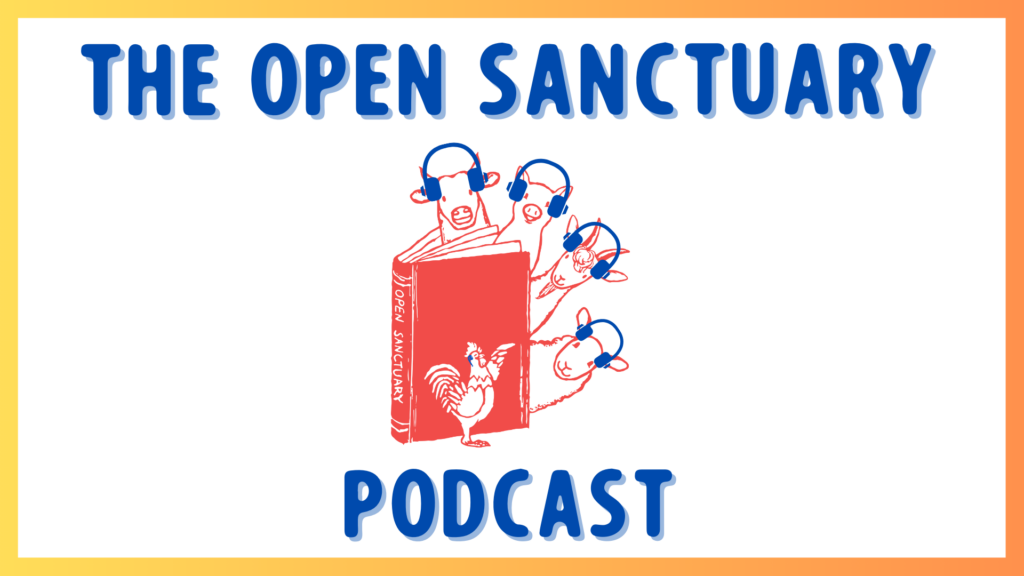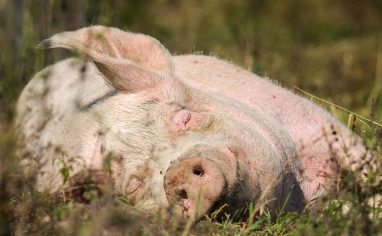
Subscribe To The Open Sanctuary Podcast
If you’d like to get the latest episodes of The Open Sanctuary Podcast, you can subscribe for free on all Podcast platforms, including Apple Podcasts and Spotify!
Episode Notes
Community Education Specialist Andie and Senior Advisor Tara revisit the topic of zoonotic diseaseAny disease or illness that can be spread between nonhuman animals and humans., this time with a focus on mitigating the risk of transmission for sanctuary personnel. We start by sharing five measures folks can implement today to help protect personnel and then discuss three additional measures folks can implement that may take a bit more time and consideration but can go a long way in keeping folks safe.
—
This Episode’s Referenced Open Sanctuary Project Resources:
Understanding Zoonotic Disease: An Overview for Animal Sanctuaries
The Open Sanctuary Podcast: Zoonotic Disease Transmission and Onsite Sanctuary Education
Establishing Safe And Effective Quarantine And Isolation Protocols For Your Animal Sanctuary
Accessibility for Folks with Physical Disabilities at Your Animal Sanctuary
Episode Transcript (Auto-GeneratedThe following content was transcribed through an automated process and may contain transcription errors or misspellings.)
Tara Hess: Hey friends, welcome back to another episode of the Open Sanctuary Podcast. I’m Tara Hess, senior advisor here at the Open Sanctuary Project, and I’m here with my friend and colleague Andie Springirth, our community education specialist. Hi, Andie.
Andie Springirth: So, some of you may have caught the previous episode that Andie and I did together, which was called “Zoonotic Disease Transmission and On-site Education.” And in that episode, we talked about the risks of zoonotic disease transmission at animal sanctuaries and what educators can do to help protect guests. So, today we’re here again to talk about zoonotic disease. Such a fun topic. Um, but this time we’re going to focus on measures that sanctuaries can implement to protect sanctuary personnel as opposed to guests. So, in the previous episode, we talked or I talked at great length about what zoonoses are, how common they are, how they spread, and which groups of humans are most at risk. And so we’re not going to delve into that as deeply this time around. That said, if the topic of zoonotic disease and what we mean by that are diseases that can be transmitted between human and non-human animals, if that’s something you’re not familiar with, I would recommend either checking out our in-depth resource on the subject, which is called “Understanding Zoonotic Disease: An Overview for Animal Sanctuaries,” which you can find on our website and we’ll link to in the show notes, or I would check out at least the first half of our other zoonotic disease podcast. So, even if you don’t welcome guests and you don’t feel like that’s not information you need right now, that first half can really help give you that foundation that I think you need to start thinking about preventing transmission. So, when we talked about protecting guests from zoonoses, the overarching theme for many of the protective measures was to eliminate risk as much as possible by doing things like preventing guests from coming into contact with certain residents or maybe certain areas of the sanctuary. When we’re talking about sanctuary personnel, and especially caregiving staff, we need to take a different approach. And so that’s not to say that there aren’t ever going to be times when you can eliminate certain risks or maybe eliminate certain risks for certain persons. But protecting sanctuary personnel generally requires you to focus on mitigating risk versus eliminating risk, simply because folks who work closely with animals are just at an increased risk of exposure to zoonotic disease. And so if we think of some of the biggest risks at a sanctuary, that’s going to be sick and quarantined residents, and of course, they need care. And so you can’t eliminate the risk of coming into contact with them. So, while some of the measures that work to help protect guests can also be applied to caregivers and sanctuary personnel more generally, for the most part, you’re going to need a different set of measures to keep personnel safe just because the degree of risk is different. Right?
Tara Hess: So, today in this episode, the way that we’re going to break this particular topic down is really in two different parts. So, in the first half, Tara and I are going to discuss measures that we can take with sanctuary personnel, in particular caregivers, that are more straightforward, and those that can be implemented right away, even things that really you can implement today. And the second half, we’re going to focus more on measures for sanctuary personnel that require maybe, you know, a little bit more time to implement and maybe a little bit more time for us to go into a little bit more detail about. So, right off the bat, let’s talk about some of the measures that we can take that you can implement today. One of the things that comes to mind for me right away is frequent handwashing. This is something we talked about in the first episode. This is pretty straightforward, but I know Tara can go into more detail about these quickly implementable tips. So, in addition to frequent handwashing or having hand sanitizer stations, what are some other things that sanctuaries can do right now to mitigate the risk of zoonoses for folks like sanctuary caregivers?
Andie Springirth: So, a lot of things that can help have other benefits. So, if anyone’s panicking, like some of these might be things that you already do, but if you don’t, here are some easy tips, easy things you can do. So, in addition to really encouraging handwashing, hand sanitizing, and making it easy, because remember caregivers, particularly caregivers, there’s more that needs to be done in a day than time to do it. Depending on the size of your sanctuary, you’re all over the place. If you provide like nice soap and warm water at one spot on the sanctuary and then there’s nothing anywhere else, like people aren’t going to be running back and forth. So, getting like hand sanitizer out there and keeping it filled up is huge. The other thing is to have a strict no food and drink policy in resident spaces. And again, there are lots of reasons why you would want to do this anyways, but doing that is going to help prevent certain types of likely disease exposure and possible transmission. And so in addition to communicating that with your staff, like make sure they have somewhere to eat that’s not right in with the residents and make sure they have time, like remember they need breaks, and make sure to give them enough time to eat so that they’re not trying to eat while they’re doing like health checks on someone.
Tara Hess: And a quick reminder for folks listening, especially caregivers, take off your gloves.
Andie Springirth: Oh my gosh. Yes. Especially now that we’re in, you know, we’re recording this in the middle of winter, at least here in the Northeast, and I am just reminded the importance of providing a separate space away and time when you feel like you don’t have time or a designated space to go eat and drink and just relax for a minute, your hands might be freezing. Like, let’s say you’re in the middle of a barn. You’re not in necessarily the living spaceThe indoor or outdoor area where an animal resident lives, eats, and rests. with the residents, but you’re potentially exposed to the elements of a 12-degree day and you need some nourishment. You know, you might not take off the gloves, the winter gloves, working gloves that you just use to provide some kind of care for a quarantined or just a resident who’s not ill but potentially does have something. So, just a mention to folks, if you are the caregiverSomeone who provides daily care, specifically for animal residents at an animal sanctuary, shelter, or rescue. listening, or if you’re in a leadership position, to encourage folks, before they eat, take off those medical gloves, take off the winter gloves, too.
Tara Hess: Yeah. Exactly. So the next thing folks can do, and this one may not be quite as easy, but it’s definitely something folks can consider and could implement quickly, is to restrict access to high-risk areas. So again, like what’s high risk? Like quarantined residents, you don’t know where they’re coming from, you don’t know what they might be shedding, sick individuals who haven’t gotten the all clear from your vet that it’s for sure not a zoonotic disease. Restricting access to those areas if possible, and I get if you have two volunteers that do everything, like that’s going to be a challenge, but just keeping in mind that more experienced folks might be better equipped to really have protective measures and an understanding of zoonotic disease like ingrained in their brain. When you have someone who’s a brand new caregiver, they’re learning so much and keeping track of so much that it’s so easy to be like hyper-focused on like, okay, I have to do this, this, this, this, and this. You totally pass by any protective gear that’s set up, a big sign that might say like, “Do not enter.” Like it’s just easy to get sort of tunnel vision on that. So, if there’s a way to do that, that can be helpful. The next thing is to provide necessary PPE. So, things like gloves, shoe covers, coveralls, all that stuff should be provided by the sanctuary. And make sure you have it in a range of sizes, because I’ve dealt with this myself where like there’s only like the small box of gloves left and you really need the medium and you put them on and you can’t do anything or there’s only that XXL and they’re just falling right off. So, not only will gear that doesn’t fit not be as effective, but it also can be really discouraging in terms of folks just being like, “What’s the point? I know you told me to do it, but like what is the point of these shoe covers that are falling off?” And then the last thing is to have a system in place for sharps and hazardous waste disposal. And the only thing I want to add to that is just folks should make sure that they’re following federal, state, and local regulations, which is going to be different depending on where folks are located. So, sort of like research what is required in your area, but making sure there’s a safe place for that stuff to go. Right.
Andie Springirth: Yeah. So again, we just covered one, two, three, four, five quickly implementable tips that folks in sanctuaries can put into place right now, right off the bat, that will help them lower the risk of zoonosisAny disease or illness that can be spread between nonhuman animals and humans. transmission. But I think it’d be helpful to start talking about some of the practices that sanctuaries can implement that might take a bit of a longer time. So, can you go into some detail about some of those things that the written resource on this topic talks about, but that’s going to be really helpful for folks to hear here as well?
Tara Hess: Yeah. Yeah. So, in addition to the things we talked about, and sort of like coupled with them, like they’re going to be more effective with these other things in place, but, you know, they’re not immediately one-and-done sort of things. So, the first is robust training. So, like you can provide protective gear for folks. You can have like a no food and drink policy in place, but if you don’t have that training component, I feel like the training component is going to strengthen everything else that you’ve got going on. And so folks really should understand the stuff that we covered in the previous podcast and the things that are in the written resource in terms of like what zoonotic diseases are, like what are we talking about? What are the different ways that they can be transmitted? Because while it would be great if we could just be like, “Do this,” and then folks did it, it’s so much more impactful for folks to understand why and feel empowered to like take measures to protect themselves. So again, like if you understand more about the fecal-oral route of transmission and how common that is and why you need to prevent it, you might be more likely to be like, “Oh, the gloves, like they were effective, and now if I like use them to like do something with my face, that’s sort of like defeating the purpose.” So, that robust training is huge. Andie and I have talked about this in the past. Training can be complicated with caregiving because things don’t always follow this really an intended path in terms of things folks are exposed to, and I don’t mean pathogens they’re exposed to, I mean experiences they’re exposed to. You know, you could have a brand new staff person who starts when you’re dealing with a really serious zoonotic disease on the sanctuary.
Andie Springirth: Yep.
Tara Hess: At the same time, you could have a caregiver who’s been there for three years and maybe, you know, has dealt with like, “Oh, we need to prevent zoonotic disease transmission generally,” that hasn’t dealt with this specific risk. It’s sometimes hard in terms of building training to time it for when it’s needed, you know? So, I think having this training be a part of your onboarding of staff so they have this foundation again, when they’re getting all this other information, they can sort of be figuring out how zoonotic disease fits in. And then also ongoing training. So, I think it would be great to do like an annual training depending on a sanctuary’s relationship with their vet, and also what they feel sort of like confident in, like maybe getting your vet involved and seeing if they’d be willing to lead, you know, an annual like retraining session, and then also building in targeted training. So again, if all of a sudden you’re dealing with a suspected risk where your vet’s like, “This might be this thing that could be really serious and is a zoonosis concern, we have to wait on diagnostics,” like now is a good time to get that training in about like the specific disease that you might be dealing with so that you can really make sure folks understand the specifics of that disease so they can make even more informed decisions about things.
Andie Springirth: You know, this makes me think about the different formats that training can be delivered to your staff, can be given to your staff. So, in the presentations you suggested with your vets, I think those are super helpful. They might even be considered workshops in some cases, but maybe you have a training manual too that folks can refer back to. Maybe you have infographics in different places throughout your sanctuary, especially for visual folks, but not just for visual, more visual folks, but also just as like constant little reminders. If you have in your medical barn or what have you, whatever you know you may call it, your sanctuary, you have an exam room and maybe on the wall right there, you have a little reminder infographic about how to safely use and dispose a syringe with a needle. That’s a really easy thing to forget when you’re kind of in the hustle and bustle of this work. So anyway, just thinking about the different ways that you can present this ongoing training. It can be verbal, it can be nonverbal. You know, I know there’s a couple other measures that you’ve suggested in your resource. What are some of those?
Tara Hess: So, the next one that I think is a really important one is clear communication, which that obviously factors into robust training, without clear communication would be like a little rough, but really making sure that folks know what’s going on. And again, this is another one that like has benefits well beyond just folks knowing current risks in terms of zoonotic disease. Like it’s huge just in terms of folks being better situated to provide the best care they can for residents because again like diseases that aren’t zoonotic are still a concern because you might be dealing with a contagious disease that can be spread around the sanctuary to other residents and so clear communication about what is going on with the residents, what is the current state of their health, just making sure people are staying informed and up to date, I think is huge because if folks, if you have all these other measures in place and they’re like, I understand zoonotic disease, I know where the personal protective gear is, but you miss that important step of being like, here’s what’s going on, here’s what we need people to do. Then things can get really busy and hectic and depending on the communication sort of systems that folks have at their sanctuary, especially if they have just like a really informal like, “Oh, we’re a small team. We’ll see each other. We’ll just put up a sign,” and so on. We’ll see it. I wouldn’t rely on that. I would make sure you’re really being proactive about just like communicating all the necessary information in a timely manner and being clear about the risks because some zoonotic diseases for healthy folks are going to be like annoying, uncomfortable, but not like life-threatening, devastating in most cases. Yeah. So, not being like zoonotic disease on the sanctuary and like really like freaking out about it, but maybe being like, “Hey, like so and so looks like they have ringworm and so we should all be really careful coming into contact with them, wearing gloves,” things like that. And then being clear if there’s a zoonotic disease concern that is a little bit maybe more concerning. Maybe you want to be like, “Hey, remember if you have concerns about the fact that you might be at higher risk, like maybe talk to your physician, get some input in terms of steps you should take to protect yourself.” Just like being, I don’t want to say forthcoming like people are being secretive, but just really making sure that you’re giving folks all the information that they need because it’s so easy because everybody, at least in places I’ve been, it’s like people are all doing their own thing, you know, working to the greater goal, but sort of working independently, passing each other by. It’s really easy to be like, “Oh, really? You didn’t know this?” Like, I just assumed that, you know, you would have heard it. And then the only other thing I want to add to that, which we did mention in the first podcast, is I would also make sure you’re really clear about like when zoonotic disease is a concern and when the concern is different. So again, not to say that if it’s like, “Oh, it’s not zoonotic,” then there’s no concern. And obviously there can be a concern of spread to other residents, but just making sure you’re explicit about that because sometimes the common names of different conditions are similar between diseases that affect humans and nonhumans, but the pathogen that causes it is different. And we talked about lice. Like, I, you know, I can get head lice, but it’s not the same as goat lice. And there are other conditions that are like that. And so the reason I bring this up is because I think if you’re clear that like, you know, “Hey, you know, there’s lice in the turkeyUnless explicitly mentioned, we are referring to domesticated turkey breeds, not wild turkeys, who may have unique needs not covered by this resource. house. Let’s be really careful not to bring it to the chickens and like the other residents who are most at risk of getting it. But don’t worry, it’s not the same as human head lice.” I think that’s helpful because if you don’t say that part, there could be folks who just don’t know that they’re not the same and jump to a conclusion. And not only can that like sort of like complicate things or make them stress out about something they don’t have to be stressed out about, but also I feel like it can give people a sense of ease of like, when there’s a zoonotic disease concern, they’re going to tell me or they’re going to tell me what the concerns are, as opposed to then feeling like, “Oh, you know, like they didn’t, like, can I trust that they’re going to give me the information?” So, just doing everything you can to make folks feel like, “Okay, I’m getting the information I need and there’s no having to like, you know, put two and two together behind the scenes,” and do you know what I mean?
Andie Springirth: Yeah. Yeah. Yeah. That’s really helpful. Two things to add to that. It’s helpful for folks who may be at an additional risk themselves and also for folks who may have friends and family back home who are at an additional risk. We’re protecting folks even beyond the sanctuary when we implement things like clear communication. The other thing that I wanted to mention here too was clear communication also means having multiple communication channels, you know, and as Tara mentioned, you may be a really small team, but it can be helpful to, okay, let’s say you have a small team, let’s start with that scenario, and so you mention it in person when you first see them, well then maybe that person has off the next two days, they come back and they forget. So, that’s why it’s important to also utilize email, especially if you have a big staff, too. I would suggest saying this in person during staff meetings or maybe when you first greet each other, in email, signage, depending on the type of risk and what it is. If you use any kind of communicative platforms like Slack, I would say that too. Any other tools your team uses, just make sure the information is updated and that you post them all of them because like I said, there have been several times in my own experience where I’ll have off for a day or two and come back and everybody’s, maybe I’ll see it with my own eyes, like, “Oh, we’re wearing boots now in this particular space. What’s going on?” Or, anyway, so just as a reminder that having multiple communication channels, I think, is also really helpful.
Tara Hess: Yeah, and your point about signage I think is a really important one because again like there’s just so much going on, so even having days off and coming back and getting in the swing of things can be a lot. But even just if you come in on your first day of the week, you’re getting hit often with a lot of different things.
Andie Springirth: That’s right. And so, even if that’s the first day anyone is finding out that like, “Oh, we’re wearing like full gear in like this specific area,” I don’t know, by the time, you know, sometimes I go in a room and I forget why I went in a room. You know, when you’re already like you’re focusing on all the different things, it can be really easy. I’ve certainly done that when signage hasn’t been used where I take that step in and then that’s when I remember like, “Crap, 100% crap, I’m supposed to be, you know, like doing this, this, or this to enter the space.”
Tara Hess: So again, I wouldn’t just rely on signage because that can be missed, but anything you can do to like get it in multiple places, I think is going to increase the chances that folks are going to remember and be able to take the steps they need to take.
Andie Springirth: And you know what this just brought up one other thing too. If you’re in any kind of leadership role, it might be helpful too to specifically ask your team what would be helpful for them. So, you know, like maybe there’s a particular way that, oh, your staff feel more receptive to getting this kind of information. What form, what tool does actually work for your team? That’s going to depend on everybody individually and also collectively as a team. So, just keeping that conversation open as well.
Tara Hess: That’s, yeah, that’s such a great point. Sort of related to that, I think if you see that things aren’t going as you anticipated, or you feel like it’s not like, you’re like, “I gave all the information. I’m doing all these things and it’s not working.” Like as opposed to approaching it like, “You guys aren’t doing the things you’re supposed to do.” Hey, like what’s going on? Like what do, what do we need to do in like leadership or the organization to better support the staff to have the information they need? And I shouldn’t just say staff, staff, interns, volunteers, whoever. Because again, like what works for a staff, you know, at one point might not work. As the team changes, different situations change. So really staying open to adjusting things as needed so that things work as well as they can.
Andie Springirth: Yep. Yep. Absolutely. And I think this is a really nice segue into one of the final points that you and I have talked about that you talk in great detail about in the written resource, which is how to foster a culture or the need to foster a culture where folks feel safe, empowered, and supported to ask for what they need. So, what would you add to that tip that can be, you know, that might take a little bit longer, you know, to nurture an environment like that?
Tara Hess: That one is hard. And I think in terms of how folks are going to do that, that’s sort of for them to explore based on their own situation and who they’re working with and their team. And I feel like especially for caregivers, like, and I don’t, I know it can get sort of dangerous to like lump, you know, a bunch of people in a group and say that they’re a certain way, but I do feel like, and I say this as a former caregiver, a former formal caregiver, you know, I still do caregiving, but, and just thinking about the caregivers I’ve worked with, some of the things that make them like so wonderful at their job, you know, or at the work is like they’re so caring and they’re so focused on taking care of others. And this is the same in other fields of caregiving is sometimes those folks need reminders to take care of themselves or even like feel like they need permission or something, you know, something like that. So, I think if you can create this culture where there’s a focus on caring for the residents but also caring for each other and looking at this as a way to care for each other. So, it’s not like Andie and I have both been pregnant while caregiving. And there’s, you know, pregnant folks are one of those like increased risk groups. And I really felt, I feel like this was sort of self-imposed, I really felt like I’m not going to use this as an excuse, you know, this isn’t going to be an excuse to like not do things. And I almost felt like I had to do more to sort of prove that I wasn’t like the weakest link. And I was the supervisor, so it wasn’t even like I had a boss like breathing down my neck or something. And I look back to that like the example I set for others because that was really just thinking about me. But when I’m thinking about the example I wanted to set for the other caregivers, like that wasn’t it. That it’s like you can’t acknowledge that in this moment or for this period of time my needs are different than they were, and I can still be an asset and I can still be useful and it’s not, I think sometimes it feels like a burden then like, “Oh now I’m a burden to others or someone else has to pick up the slack,” and it’s, I’m not saying it’s not complicated to make this happen, but to find a way to make it happen where it’s okay to say that you need something, that you need a modification to your work and that it can be done in a way that again doesn’t create this resentment. Because at some point we might all need it. You know, we might all need different modifications at different points. So, just normalizing that and making it okay as opposed to being this like shameful thing where sometimes folks are going to, I for sure put myself in unsafe situations because I felt this need to sort of like show that like it didn’t make me a worse caregiver, the fact that I was pregnant.
Andie Springirth: Just to echo off of that too, Tara, you brought up a really important word which is modifications. So, I would suggest to particularly if you’re in any kind of leadership role at a sanctuary that you, you from the get-go implement a good modifications policy and let even potential hires know about this, but especially your current staff. And what that means is just that you have, you and your staff have the ability to remain flexible within the giant purview of all of their, you know, tasks and duties as a caregiver, and just remaining flexible that those are going to change depending on the individual. It could change yearly. It could change day to day, weekly, hour to hour. I mean there’s, there’s, there’s just as Tara mentioned, at some point we all need modifications. And I think it’s important to not create this monolith role of every caregiver must be able to do all of these 1,000 things every single day depending on people’s abilities and how those change. That’s not always the case. So, just having a good modifications policy in place, letting your team know, I think it’s critical to have one for your staff and as we mentioned in the first part of this too, to have one for your on-site visitors as well. And then you’re prepared, you’re prepared in advance for this. Okay, this person, you know, as Tara mentioned, we’ve both been pregnant as caregivers. How can you prepare in advance for staff to potentially become pregnant at some point? There’s lots of things to consider with that. And again, just staying in conversation with your staff members and being open to their requests. I also just wanted to point out too that Tara, you mentioned that when you became pregnant, you didn’t want to use it as an excuse to do things differently or to not do things. And I think part of that is just the nature of this type of work is we, we’ve talked about it a lot of times. It’s just go, go, go. And so I would also just encourage folks that this is, this is a good time to remind yourselves and your staff to slow down whenever they can. I think that’s a big part honestly of nurturing a culture that’s supportive and safe. When we slow down a little and we remind ourselves to do that, we’re able to make more responsible, safer decisions. And that includes stopping to pause and be like, “Okay, how am I feeling today? How has my particular situation changed?” Or maybe if you’re in a leadership role, “How has this particular person’s situation changed? You know, what can I do to make sure that they’re comfortable?” In particular, since this episode is on zoonotic disease, right, there are varying risks depending on what folks are going through or what they need. And also with that said, if you’re listening and you’re like, “I’m a one-person show here,” like you’re the sole operator of your residence, you know, or maybe it’s just a two-person team. All of these things can be applied to you as well. Like just a reminder that you, you, you should check in with yourself as well. If you find yourself in need of some modifications, it’s okay to do that. So, encouraging you here, giving you permission here for what it’s worth to create a supportive culture for yourself as well. I think that’s, that’s also really critical. So, we’ve talked about several different tips that sanctuary folks can implement both right away and also a few other really important things that they can do over a longer period of time. If you all have any further feedback about other things, other ways that your sanctuary or rescue mitigates the risk of zoonotic disease transmission and you want to share it with us, please feel free to do so. You can go to our contact page on our website at www.opensanctuary.org or you can DM us on our social media. We’re, we’re always evolving and adapting our resources and we’d love to hear from you about other responsible practices that, that, that we can share with folks to implement. Otherwise, we want to thank you so much for tuning in to this episode. We hope this was helpful. Another friendly reminder, if you’re listening to this and you’re like, “I don’t know what zoonotic diseases,” as Tara mentioned at the beginning, please do check out part one of this topic that’s on zoonotic disease with sanctuary educators. But that first half of that episode really goes into more detail about what zoonotic disease is, how it spreads, et cetera, as well as checking out the written resource, which goes into even greater depth of detail about this topic that Tara wrote. We’ll also leave any other relevant resources that, you know, may have come up during this episode in the show notes, so please check those out as well. And if you’d like to leave us a review of this podcast and share it with others, if you’ve enjoyed listening to it, we really, really appreciate your continued support. So, thank you so much again for tuning in. Bye-bye, friends.

Got A Podcast Idea? Contact Us!
If you have a topic or question you’d love to hear our staff address on The Open Sanctuary Podcast, please get in touch via our contact form!








